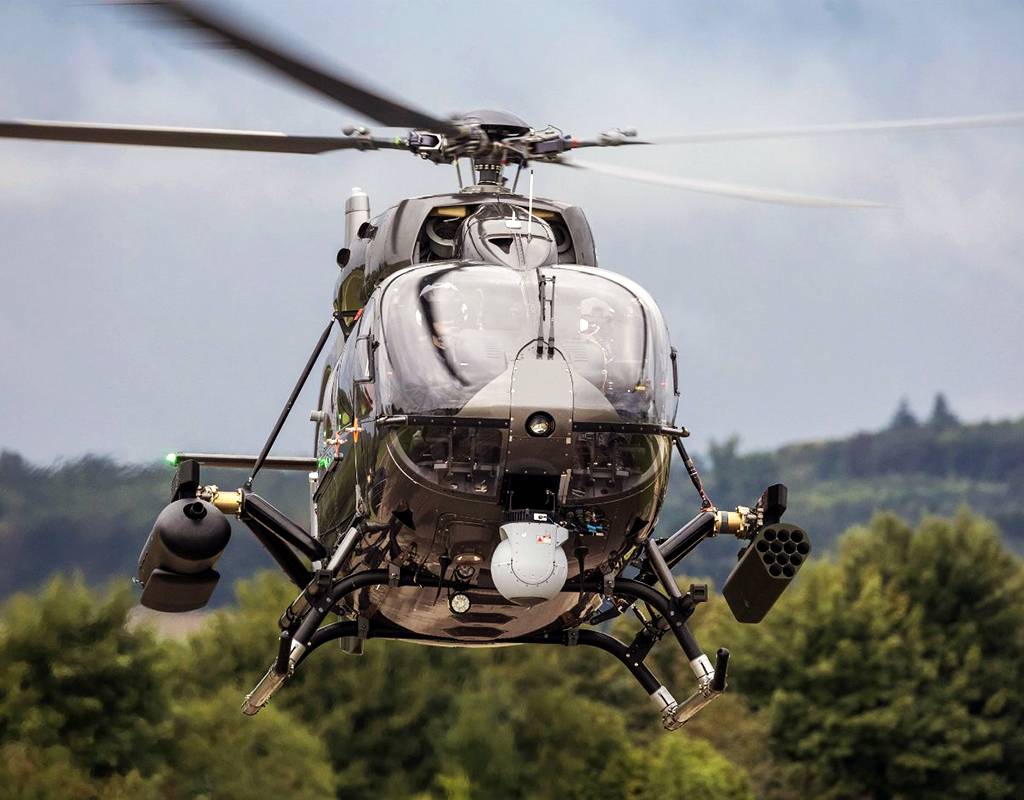
Airbus is in the final phases of teaming its militarized H145M with unmanned aerial systems (UAS) and is already confident enough in the development that the capability is available to customers interested in the five-bladed attack helicopter.
After the successful launch of the new five-bladed H145M in 2020 — increasing the useful load of the helicopter by 330 lb. (150 kg) — Airbus began planning for future capability upgrades to satisfy the requirements of prospective customers, Mark Henning, the company’s H145 program manager, said during a trade media briefing broadcast Nov. 30 from Munich, Germany.
Manned-unmanned teaming, or MUM-T, was one of the capabilities identified as desirable to countries who wanted to extend the range and aperture of their attack/recon aircraft but could not afford the more sophisticated systems used by the U.S., Henning said.
“Next week, we shall be finished with our phase two tests, with this undisclosed unmanned aerial system,” Henning said. “Currently we have offered it once to a customer, with a so-called committed offer. So, that means there’s a price, there’s a lead time, there’s performance and capability behind that. That means that based on all the tests we’ve done up to now we are ready to offer this to the public.”
Airbus is targeting parapublic operators who could use a robotic wingman for search-and-rescue missions, law enforcement and military customers.
The company has been working since 2018 to integrate various drones with the five-bladed H145. At that time, the MUM-T concept was proven with the Schiebel S-100 vertical takeoff and landing drone. During that testing, Airbus was able to achieve level-five connectivity with the UAS, meaning the H145 pilots were in control of the S-100 during the entire flight, including takeoff and landing. The UAS also transferred full-motion video, images and other data directly to the H145M cockpit.
“We did with the rotary . . . because we thought it fits quite well to the operation, the VTOL capability,” Henning said. “This weekend, the next weeks while we’re flying, we’re using a fixed-wing drone, also having a bit of a proper flight time, which is about five hours’ flight time, which is a good thing. The day after tomorrow, we’re going to use an even smaller UAV . . . like below 10 kilograms [22 lb.]. We’re working with all kinds of drones.”
In 2022, Airbus Helicopters will work with the company’s defense and space division to pair the H145 with its Remote Carrier (RC) “loyal wingman” technology, which involves large, jet-powered fixed-wing drones launched from transport aircraft like an A400M, Henning said.
“This is a multi-year approach,” Henning said. “It’s a stepped approach. We saw that the operation of unmanned systems was not yet certifiable in the EASA perspective in Europe, and this is still a challenge, which since then, is really overcome step by step by step on the industry side, as well as on the legislation side and the authority side to get operations really possible.”
During the 2018 trials with Schiebel’s S-100, Airbus found that to certify MUM-T in Europe, the link between aircraft and drone would have to be more “robust,” Henning said. To enhance its ability to integrate both with UAS and other NATO systems the H145M also will be equipped with standard datalinks like Link 16, the variable message format (VMF) and cooperative electronics support measures operations (CESMO), a recon network linking various armed forces and platforms that locates threats using the electromagnetic spectrum.
Those new datalinks and the interoperability they promise were put to the test during the German Luftwaffe-hosted Timber Express exercise this year, the second iteration of the multi-domain exercise in which the H145M has participated, Henning said.
During the combat rehearsal, the H145M was deployed as a close air support asset using new digital technology that helped ground troops transmit targeting data to the helicopter, which then assisted pilots in identifying and attacking the target.
“We had a lot of assets in the air, which was quite interesting,” Henning said. “We had strike aircraft, which were Tornados. We had combat air patrol aircraft, which was a Eurofighter, and we had NH90 as well as other helicopters flying with us on an assault mission.”



